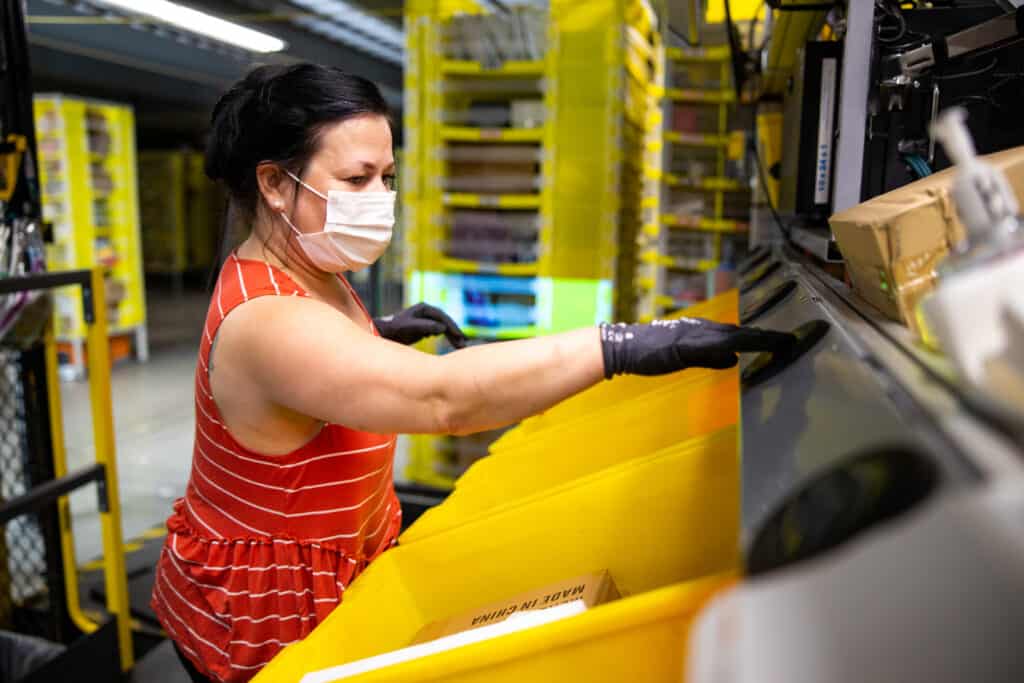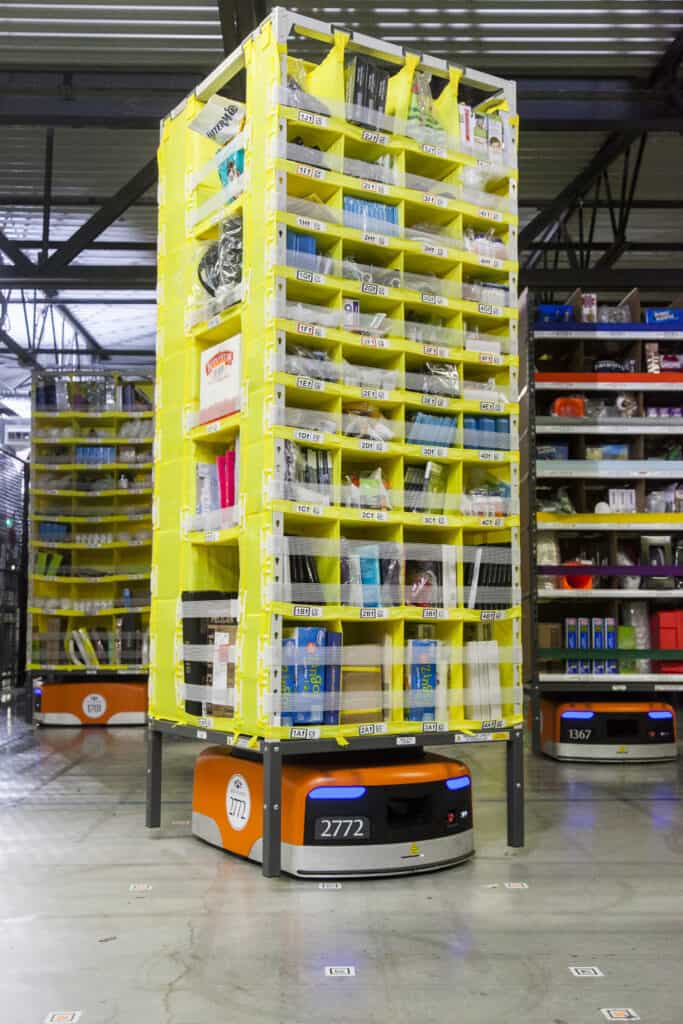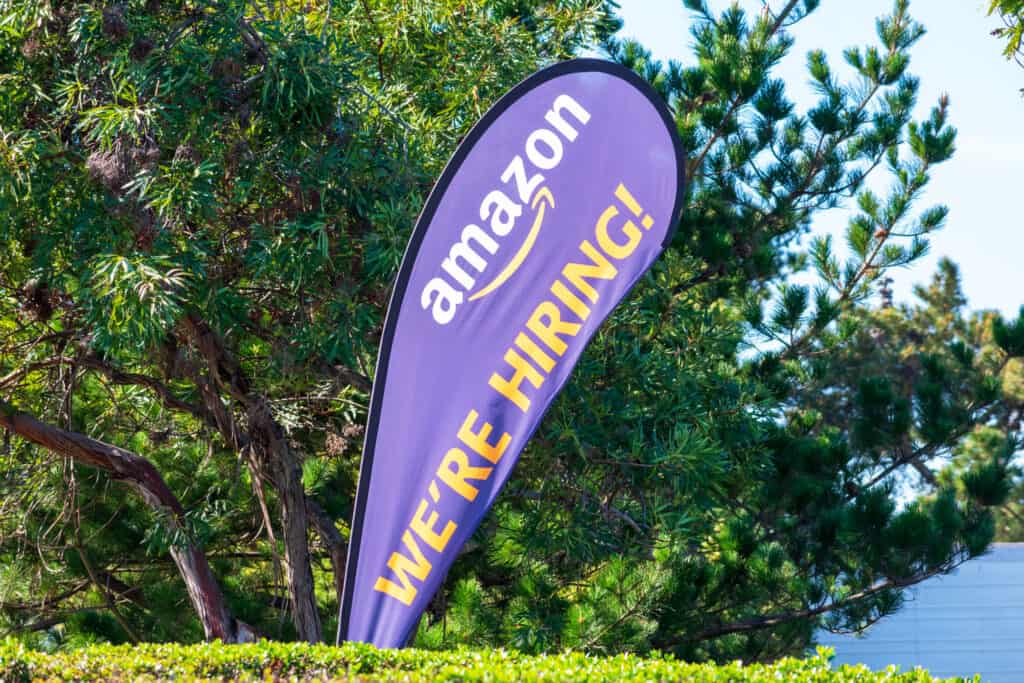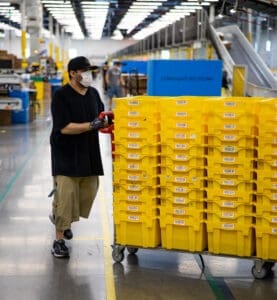
Stowing is one of the most common jobs at Amazon warehouses. Stowers can be found in both Amazon fulfillment centers (including Amazon robotics facilities) and sort centers.
Stowing is the process of storing incoming inventory into an appropriate storage location for future retrieval. Stowing is also referred to as putaway in other warehouses.
At Amazon facilities, a stow associates’ main task is to receive inbound stock, placing it into storage locations such as pods or racks (in VNA facilities) and then scanning them to enter the items into the inventory system.
Stowers perform their tasks differently depending on the kind of facility they work in, i.e., in PIT centers/non-robotic facilities, they will use order pickers to stow items in racks while in Amazon Robotics (AR) facilities, they stow items in pods that are delivered by robots.

Job Description
The day-to-day tasks of an Amazon stower include:
- Picking, scanning and placing items into storage shelves in a fast and efficient manner.
- Maintaining a minimum rate of scanning and putting away items (around 450 items an hour).
- Following the right procedure to operate a handheld scanner.
- Placing items into the correct size shelves/slots/bins for storage.
- Keeping items in the storage bins organized, with safety in mind.
- Keeping the work station clean and clutter-free.
- Safely driving an order picker in VNAs (very narrow aisles) – for non-robotic Amazon facilities (PIT centers).
- Following proper safety protocols, e.g. by wearing safety vests and steel-toe shoes.
Training

All new Amazon hires are given a specific “path” or role in which they will be working on the first or second day or during orientation. For example, you could be a stower, picker, packer, etc.
Before being assigned a path, all new hires are given general training using video, slides and tests. After being assigned their path, they are given more specialized training concerning that particular path.
Training is given by “learning ambassadors“, which is Amazon’s terminology for trainers.
In the first few days of working independently, these learning ambassadors will be available to provide guidance and answer any questions pertaining to your job.
Note that you may get cross-trained in other paths such as pick, pack or ship dock as needed. So you might not always work as a stow associate during your employment.
Pay and Benefits
Stowers get the same pay as all other tier 1 associates in Amazon warehouses. The minimum pay for entry-level employees is $15 an hour but can be as high as or more than $20 an hour in some locations.
Amazon gives sign-on bonuses as high as $3000 in some locations.To get the full amount, you will need to have worked at the facility for at least 180 days.
Amazon workers also get paid time and a half or double time during peak seasons and overtime.
Amazon also gives excellent benefits to its workers, including those who work in stow. This includes health and dental insurance, 401(k) savings plan, parental leave, tuition assistance, paid vacation, and much more.

How to Get Better at Stowing
Focus on quality in the beginning and don’t worry too much about rate. Learning how to stow without mistakes will help you in the long run since bad quality also impacts your rate.
Stow a bunch of smalls very fast when you start work or immediately when you get back from a break. This will help keep your takt time as low as possible closer to the end of your shift when you are tired and slower.
Try to stow at least one item in a pod before releasing it. This reduces your takt time and TOT.
If you have multiple similar items with tiny barcodes that are hard to scan, place one item on the sled on your station to scan and just pick the other items from the box and stow them after each scan. This is a better alternative than scanning each of them manually, which takes a lot of time.
Keep your smalls closest to the scanner and heavy items the farthest. Keeping small items far from the scanner is disadvantageous since they take the smallest amount of time to scan.
Do not overstuff bins with items because it will increase the risk of them falling, which can damage them or cause injuries to other associates such as pickers. Overstuffing can also get you into trouble with PAs and area managers.
Don’t stow small items into the large item bins at the bottom of the pods. You or other stowers might need to use them for large items later and it just wastes everyone’s time when trying to find space for 14″ to 18″ items.
Grab, scan and stow multiples of smalls at a time if you have a lot of them as opposed to picking them from a box each time. This keeps your takt time at a minimum.
Additional Tips
Bring a bottle of water. Staying hydrated will keep you from getting exhausted and replenish fluid lost through sweating. Make sure not to drink too much though because frequent visits to the bathroom can result in too much TOT.
Be friendly with the waterspiders. They are your link to replenishing resources such as items for stowing and cutting your boxes. Being cordial with your waterspiders will make your job a lot easier.

Wear good shoes. You will be standing for hours on end and your feet will be sore by the end of your shift. Lightweight and comfy work shoes are important to avoid foot pain when going to bed after your shift.
Amazon gives an annual $110 credit to buy work shoes from Zappos through the Zappos at Work program. Take advantage of this so you don’t have to spend money out of pocket on these shoes – which can be expensive.
Eat a well-balanced diet and get enough sleep. This will keep you energized in the long run and contribute to better performance at work.
Do not overwork yourself. Doing so may lead to fatigue or burnout. Remember, Amazon pays the same no matter how much you work. So just focus on staying above the minimum rate.
Take pre-workout if you can. Being a stower is a little bit like going to the gym. You will need a lot of energy to keep your momentum. Gorilla Mind is a good choice and is made by a popular fitness enthusiast and Youtuber named Derek.
Beware that pre workouts have large amounts of caffeine which might cause side effects such as tingling sensations in your skin. Take it slow at first to see how much you are comfortable with.
Bring wireless earbuds if you can get away with it or if your building’s management is lax about it. Stowing is pretty monotonous so listening to music or podcasts while working can help pass the time quickly.
Do this with caution because if your building’s management is against wearing earbuds, you could be written up for safety violation.
Pros and Cons of Being a Stower
Pros
Stowing can help you keep fit since it involves quite a bit of movement and lifting. Like most jobs in the warehouse, expect to burn a lot of calories during your workday.
Unlike other paths at Amazon facilities such as picking, stowing involves less walking, especially in robotized facilities. In legacy (non-robot) facilities, you get to use motorized machinery, i.e. PIT.
Relative to many other warehouses, Amazon pays well for entry-level work such as stowing.
Cons
Keeping up with your rate is very difficult for many employees. In fact, this partly contributes to the high turnover rate at Amazon warehouses.
Many associates find stowing to be mind-numbingly boring. Stowers do repetitive work every day for hours.
In AR facilities, you may constantly get overstuffed bins in pods which slows you down.
Constant lifting, bending and twisting as a stow associate will lead to soreness during or after your shift.
It’s easier to make errors (such as double scanning) in the stow department more than in other departments. Remember that poor quality (e.g. errors) can lead to write-ups and eventually termination.
Like with most Amazon entry-level positions, it’s hard to move up the ladder, especially if you don’t have a degree.